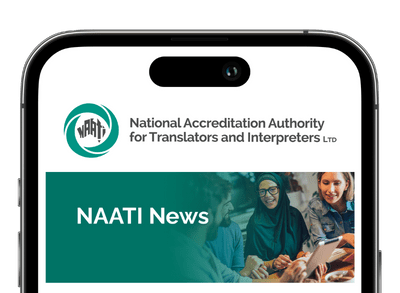Welcome to a big step for NAATI, as we publish the first post of our new blog.
“Why?” I hear you ask, “Isn’t there enough information on your website without adding more?”
Of course, we have a lot of information and advice on our website, but we wanted to provide a more informal way to connect with you – whether you are a translator or interpreter, someone working in migration, or at a university. Really, anyone that has an interest in our industry and the brilliant idea of a connected community without language barriers.
So, what can you expect? Firstly, regular posts and, using the link in the side bar, an opportunity to subscribe to our blog. It will cover many topics as we see the blog as a sort of newsroom. A place that anyone interested in our work can find out what we are doing, what we have done and, a look into the future of our organisation.
Our 40+ year history as an integral part of the industry gives NAATI a unique perspective, and in a year of global challenges we want that experience to be of value to all those that interact with our organisation.
In the coming weeks and months, you will see posts from NAATI staff, guest authors and from organisations both local and global. You will read about the progress of our funded research work, new languages we are certifying, professional development opportunities, and the broader work of NAATI.
Our intention is to make our blog topical, informative and, above all else, engaging.
Already in the pipeline are posts from Gulnara Abbasova, Ludmila Stern and Oktay Eser. We will publish some informative posts on days special to our industry, such as International Translation Day.
Of course, we want to hear from you and what topics you would like to see covered in future posts. The T&I industry impacts so many lives – Indigenous, migrant, and refugee – in a positive way and we know that there are plenty of stories to tell and share.
This year NAATI has added ten languages to its certification program. These are Bangla, Burmese, Filipino, Hindi, Nepali, Pashto, Somali, Swahili, Tamil, and Thai. Combined, these languages are spoken by more than 1.2 billion people globally, and by more than 640,000 people in Australia.
By far the most widespread of these is Hindi, spoken by 612 million worldwide, but in Australia the number is 160,000. By comparison, there are only 16 million speakers of Somali worldwide, and 16,000 of them are in Australia. The story of languages and the people that speak them is fascinating. From Indigenous Kriol to the more than 300 types of sign language used across the globe.
NAATI’s vision of a ‘connected community without language barriers’ keeps me, and the rest of our organisation, engaged in the pursuit of quality in the translating and interpreting industry. Not least because of the need for standards but, most importantly, to meet the needs of all Australians.
Ultimately, it is about equity, participation, and inclusion.
